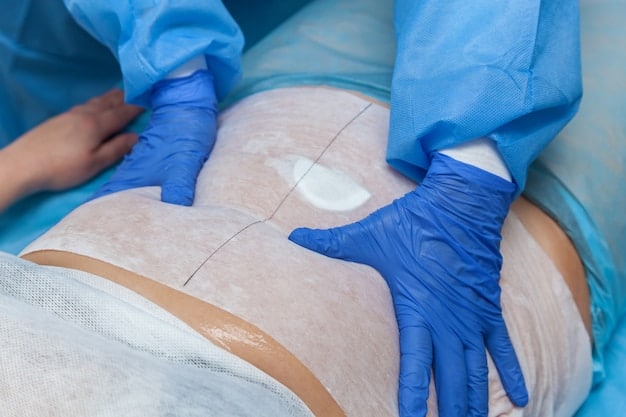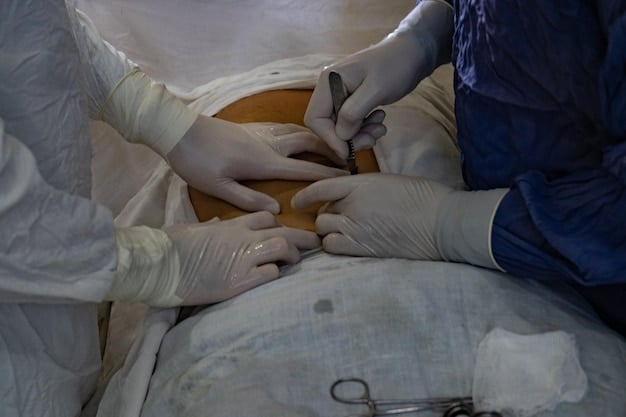Tummy Tuck: Your Guide to a Flatter Stomach in 9 Months

A tummy tuck, or abdominoplasty, is a surgical procedure designed to flatten the abdomen by removing excess skin and fat and tightening abdominal muscles, with results typically visible within nine months as swelling subsides and the body adjusts.
A **tummy tuck (abdominoplasty): Achieving a flatter stomach and tightening abdominal muscles in 9 months** is a transformative procedure for those seeking to improve their abdominal profile. Understanding the process, recovery, and expected outcomes is crucial for making an informed decision.
What is a tummy tuck?
A tummy tuck, also known as abdominoplasty, is a surgical procedure to remove excess skin and fat from the abdomen and tighten abdominal muscles. It’s a popular option for individuals who have experienced significant weight loss, pregnancy, or aging, which can lead to stretched skin and weakened abdominal muscles.
The procedure can dramatically reduce the appearance of a protruding abdomen, creating a smoother and firmer abdominal profile. However, it’s important to understand that a tummy tuck is not a weight loss surgery but rather a contouring procedure.

Who is a good candidate for a tummy tuck?
Ideal candidates for a tummy tuck include individuals who are in good overall health, have a stable weight, and are bothered by excess skin and fat in the abdominal area. It’s also important to have realistic expectations about the outcome of the surgery.
Women who have had multiple pregnancies and have stretched abdominal muscles are often good candidates. Additionally, individuals who have lost a significant amount of weight and have excess skin may benefit from a tummy tuck.
Types of tummy tuck procedures
- Full tummy tuck: Involves an incision from hip to hip and may include repositioning the belly button.
- Mini tummy tuck: Suitable for those with excess skin and fat below the belly button, requiring a smaller incision.
- Extended tummy tuck: Addresses excess skin and fat in the abdomen and flanks, with a longer incision.
- Circumferential tummy tuck: Removes excess skin and fat from the abdomen, back, and hips, providing comprehensive contouring.
Choosing the right type of tummy tuck depends on individual needs and goals. During a consultation with a qualified plastic surgeon, the best option will be determined based on a thorough evaluation.
In conclusion, a tummy tuck is a procedure designed to improve the abdominal profile by removing excess skin and fat, and tightening the underlying muscles. Understanding the different types of procedures and who is an ideal candidate is essential for making an informed decision.
Preparing for your tummy tuck
Proper preparation is essential for a successful tummy tuck and a smooth recovery. This involves both physical and lifestyle adjustments to optimize your health and minimize potential complications.
Following pre-operative instructions carefully can significantly impact the outcome of your surgery. It’s also important to have a clear understanding of what to expect during and after the procedure.
Medical evaluation and consultation
A thorough medical evaluation is a critical first step. This includes a review of your medical history, a physical examination, and potentially some lab tests. The goal is to ensure that you are healthy enough for surgery and to identify any potential risk factors.
During the consultation, discuss your goals and expectations with your surgeon. They will assess your abdominal area, explain the different types of tummy tuck procedures, and recommend the best option for you.
Lifestyle adjustments
- Quit smoking: Smoking can impair blood flow and delay healing, increasing the risk of complications.
- Maintain a stable weight: Fluctuations in weight can affect the results of your tummy tuck.
- Avoid certain medications: Some medications, such as blood thinners and anti-inflammatory drugs, can increase the risk of bleeding during and after surgery.
Making these lifestyle adjustments well in advance of your surgery can improve your overall health and reduce the risk of complications. It’s also important to inform your surgeon of any medications or supplements you are taking.
Preparing for a tummy tuck involves a comprehensive approach that includes medical evaluations, lifestyle adjustments, and a clear understanding of the procedure. By following these steps, you can increase your chances of a successful outcome and a smooth recovery.
The Tummy Tuck Procedure: What to Expect
Understanding what happens during a tummy tuck procedure can help alleviate anxiety and prepare you mentally for the experience. The procedure itself involves several key steps, from anesthesia to incision and muscle tightening.
Knowing the details of the surgical process will give you a clearer picture of the journey toward achieving a flatter stomach.

Anesthesia and Incision
Typically, a tummy tuck is performed under general anesthesia, ensuring you are asleep and pain-free throughout the surgery. The type of anesthesia will be determined during your pre-operative consultation.
The incision’s length and pattern depend on the chosen technique. A full tummy tuck usually involves a horizontal incision from hip to hip, just above the pubic area. A mini tummy tuck requires a smaller incision, while an extended tummy tuck involves a longer incision extending around the hips.
Muscle Tightening and Skin Removal
Once the incision is made, the surgeon lifts the abdominal skin to access the underlying muscles. These muscles, which may have weakened or separated due to pregnancy or weight loss, are then tightened with sutures.
Next, the surgeon removes excess skin and fat from the abdomen and redrapes the remaining skin to create a smoother contour. The belly button may need to be repositioned for a natural appearance.
Closure and Initial Recovery
- Incision Closure: The incisions are closed with sutures, which may be dissolvable or require removal later.
- Dressings and Garments: Dressings are applied to protect the incisions, and a compression garment is worn to minimize swelling and support the healing tissues.
- Immediate Post-Op: After the procedure, you will be monitored in a recovery room before being discharged to continue your recovery at home.
The tummy tuck procedure involves anesthesia, incision, muscle tightening, skin removal, and closure. Understanding each step will help you better prepare for the surgery and recovery process, leading to a smoother experience and optimal results.
The First Few Weeks: Initial Recovery Period
The initial weeks following a tummy tuck are critical for proper healing and achieving the best possible results. Managing pain, caring for your incisions, and understanding the limitations are all essential during this period.
Following your surgeon’s instructions carefully will help minimize complications and support a smooth recovery process.
Pain Management and Medication
Pain and discomfort are common after a tummy tuck. Your surgeon will prescribe pain medication to help manage this. It’s important to take the medication as directed and to communicate any concerns about pain levels.
In addition to prescription pain relievers, some individuals find relief through over-the-counter options like acetaminophen. However, it’s crucial to avoid medications that can increase bleeding, such as aspirin.
Incision Care and Hygiene
- Keep Incisions Clean: Gently clean the incisions with mild soap and water as instructed by your surgeon.
- Apply Ointments: Use any prescribed ointments to promote healing and prevent infection.
- Monitor for Infections: Watch for signs of infection, such as increased redness, swelling, warmth, or drainage, and report any concerns to your surgeon.
Proper incision care is vital for preventing infections and ensuring optimal healing. Following your surgeon’s specific instructions will help minimize the risk of complications.
The first few weeks after a tummy tuck involve managing pain, caring for your incisions, and following your surgeon’s instructions closely. By prioritizing your health and recovery, you can minimize complications and set the stage for a successful outcome.
Months 2-6: Gradual Return to Normal Activities
As you progress into months two through six of your tummy tuck recovery, you’ll gradually start to regain your normal activities. It’s essential to ease back into your routine to avoid setbacks and ensure continued healing.
Understanding the gradual progression of activities and knowing when to push yourself (and when to hold back) can significantly impact your recovery.
Resuming Light Exercise
Light exercise, such as walking, is generally encouraged after a few weeks to promote circulation and prevent blood clots. However, avoid strenuous activities like heavy lifting or intense aerobics.
Start with short walks and gradually increase the duration and intensity as you feel comfortable. Listen to your body and stop if you experience any pain or discomfort.
Returning to Work and Social Activities
- Assess Your Comfort Level: Most patients can return to work within a few weeks, depending on the physical demands of their job.
- Avoid Prolonged Sitting or Standing: Take breaks to move around and stretch.
- Gradually Reintegrate Socially: Start with short outings and avoid activities that could strain your abdominal muscles.
Returning to work and social activities should be a gradual process. Prioritize your comfort and well-being, and don’t hesitate to take breaks when needed.
Months two through six of your tummy tuck recovery involve gradually returning to normal activities, including light exercises, work, and social engagements. By easing back into your routine and listening to your body, you can support continued healing and avoid complications.
Months 7-9: Final Results and Maintenance
By months seven through nine, you’ll begin to see the final results of your tummy tuck. Swelling will have subsided, and your abdominal contour will be more defined. Maintaining these results involves consistent effort and lifestyle choices.
Understanding how to optimize your long-term outcomes ensures that you continue to enjoy the benefits of your tummy tuck for years to come.
Assessing Final Results
During this period, you’ll notice a significant improvement in your abdominal appearance. Excess skin and fat will be gone, and your abdominal muscles will be tighter. Scars will continue to fade over time.
Regular follow-up appointments with your surgeon will allow them to assess your progress and address any concerns. Photos may be taken to document your results.
Maintaining Long-Term Results
- Maintain a Stable Weight: Fluctuations in weight can affect the results of your tummy tuck.
- Exercise Regularly: Engage in a consistent exercise routine to maintain muscle tone and overall health.
- Eat a Healthy Diet: Focus on a balanced diet rich in fruits, vegetables, lean proteins, and whole grains.
Maintaining long-term results requires a commitment to a healthy lifestyle. By maintaining a stable weight, exercising regularly, and eating a balanced diet, you can continue to enjoy the benefits of your tummy tuck for many years.
Months seven through nine mark the final stages of your tummy tuck recovery, where you’ll begin to see the full results. Maintaining these results involves a commitment to a healthy lifestyle, including maintaining a stable weight, exercising regularly, and eating a balanced diet.
| Key Point | Brief Description |
|---|---|
| 💪 Muscle Tightening | Abdominal muscles are tightened during the procedure. |
| ⏳ Recovery Time | Full results visible around 7-9 months post-surgery. |
| 🚭 Lifestyle | Quit smoking and maintain a stable weight for best results. |
| 🔪 Incision Type | Varies based on the type of tummy tuck performed. |
Frequently Asked Questions
▼
No, a tummy tuck is not a weight loss surgery. It is a contouring procedure designed to remove excess skin and fat and tighten abdominal muscles. It is best suited for individuals who have already achieved a stable weight.
▼
The final results of a tummy tuck typically become visible around 7-9 months after the surgery. This is the time it takes for swelling to subside completely and for the body to adjust to the new contour.
▼
A tummy tuck is usually performed under general anesthesia. This ensures that you are asleep and pain-free throughout the procedure. The specific type of anesthesia will be determined during your pre-operative consultation.
▼
Potential risks and complications of a tummy tuck include infection, bleeding, scarring, poor wound healing, and changes in skin sensation. It is important to discuss these risks with your surgeon before proceeding with the surgery.
▼
To maintain the results of your tummy tuck, it is important to maintain a stable weight, exercise regularly, and eat a healthy diet. Avoiding significant weight fluctuations and following your surgeon’s aftercare instructions are also crucial.
Conclusion
Achieving a flatter stomach and tighter abdominal muscles through a tummy tuck involves a comprehensive journey from preparation to long-term maintenance. By understanding the procedure, following your surgeon’s instructions, and committing to a healthy lifestyle, you can enjoy the transformative results of a tummy tuck and maintain your new abdominal contour for years to come.





